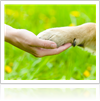Caring for Your Pet’s Paws
Posted on Jan 15, 2014 3:39pm PST

Animals spend most of their day walking around on their paws. That is why it is so important for you to care for your pet's paws and make sure that they stay healthy. If you notice that your dog's paws happen to be swollen, then you may want to check and see if a foreign object has gotten stuck in the pads of your pet's feet. Insect bites or spider bites are another possibility, as it's not impossible that you pet may have stepped on an insect and gotten an unwelcome punishment. Some pets will suffer swollen paws when they step on a bee or wasp and subsequently get stung. In addition to this, pets may have swollen paws if the pad has been punctured by a needle, thorn, or another sharp object.
While humans have shoes to protect their feet from being punctured, pets do not. Animals can easily step onto a sharp object and suffer a puncture wound which will cause their pads to swell. Pets sometimes suffer fractured claws, which will cause the paw to swell, or broken toes. You can determine whether or not your pet has swollen pads by watching his or her gait. Is your dog limping? Is she favoring a leg, or is he hobbling along. Does he wince when he puts weight on a particular leg? Is your pet avoiding one foot?
Check your dog's top and underside of the paw for swelling and pain whenever you notice that your animal is limping. Catching issues at the outset may help you to prevent your pet from suffering lameness later on. Before taking your pet to the vet, check the paw for any objects that could be caught between the pads and toes. Sometimes even something small such as a thistle or a pebble can cause your dog pain and make him or her limp. Make sure that there are not small thorns that have wedged their way in your pet's paw.
As well, check for any insect stings or puncture wounds. These are typically hard to pinpoint, but you may be able to do so if you run your hand over the paw and determine where it hurts. You may be able to remove a stinger or a trapped object with tweezers. If you plan to do this, be very careful and don't forget to wash the paw with warm and soapy water to help avoid infection.
If you can't locate an object in your pet's paw, you may want to try soaking it in Epsom salt. Put your pet in a hot water bath or put his foot in a tub of the salty water. Allow the pet's paw to remain in the water for at least ten minutes with dissolved Epsom salts. This should temporarily reduce the swelling. If the swelling comes back, then you may want to take your pet to a local veterinarian for a check-up. There could be an internal problem that could cause the limping that needs to be treated.
Sometimes, pets will suffer paw lesions, and this will cause the swelling to persist. In this case, you will want to take your animal to the vet to get advice. Another cause for paw swelling occurs in the summer when pets are running on hot asphalt and pavement. The animal may suffer burns on his or her feet when the pavement is particularly hot, Do your best to avoid walking your pet on hot surfaces. Also, don't take your pet on walks that go through overgrown ground or jagged terrain, as these locations may have thorns and other items that could puncture your pet's foot. If you want assistance with your pet then don't hesitate to call a local vet!
Related News:
Posted on May 28, 2014
Nutrition is one of the most important things to get right when it comes to taking care of a kitten, helping them develop into a healthy, strong cat. This means knowing how to find the right food, ...
Read More »
Posted on Jun 12, 2013
Cats can develop a variety of fungal infections, and one of the most common infections is termed aspergillosis. This is an infection that is caused by Aspergillus, which is a common mold that is found ...
Read More »
Posted on Feb 13, 2013
When a pet has cancer, the owners often have a lot of questions. As a devoted pet owner, you may be very concerned about your pets’ well-being and be searching for answers. You should always ...
Read More »